Mobile Web Traffic Stats and Facts in 2023
Not that long ago, we used to talk on phones that were the size and weight of a brick. A mere thirty years later, we have phones in our pockets that outperform the computers that sent humanity to the moon.
The world of smartphones is one of the most exciting tech scapes out there. Not only are phones improving with every generation, but they’re becoming cheaper as well. Now, you still can’t get the latest iPhone for cheap, but with the advent of new manufacturers and brands, you can now purchase a mobile phone with exceptional features and performance for next to nothing.
These days, phones are something most people in the world can’t live without. They’ve become so popular, widespread, and useful that they can become pretty addictive. Today, to explore this world further, we’ll delve deeper into the world of mobile traffic statistics.
Below, we’ll discuss general mobile statistics and facts, explore some common mobile internet activities, and touch on the latest broadband networks like 5G and 6G.
Interesting Mobile Traffic Stats
- Mobile devices have over 57% of the worldwide market share when compared with desktop computers.
- Mobile devices account for about 47% of all online traffic in the US.
- US smartphone users spend about 82 minutes on smartphone based social media apps and websites daily.
- Mobile apps account for 56% of web page views worldwide in 2021.
- WhatsApp had 2 billion active users as of January 2021.
- 58% of all US smartphone users prefer websites and apps that remember them and their past activity.
- Video is the most popular app category on smartphones in 2021 with 47.24 exabytes of data used.
- 5G coverage is expected to reach about 60% of mobile devices by 2026.
- The fastest mobile connection speed is in South Korea with 113 Mbps.
General mobile traffic stats and facts
With each passing year, the mobile phone industry is getting bigger, and mobile traffic is growing. While new applications come and go, the continual growth trend of mobile devices allows for remarkable growth in app success, numbers, and popularity.
Mobile traffic has now overtaken desktop in the digital landscape, and that trend is projected to grow even more as the years pass.
Below, we’ll take a look at some general mobile traffic statistics and facts.
1. Mobile devices account for about 47% of all online traffic in the US.
Mobile devices are ever-so-popular. Today, they’ve cemented their role in global internet traffic. In the US, almost 47% of all online traffic is from smart mobile devices.
Many companies, including a number of digital commerce companies, have completely skipped the desktop internet phase in favor of mobile applications.
Well-established businesses also favor their mobile apps and websites by offering discounts, exclusives, and other promotions in the same vein.
Some other countries with a very prominent online traffic share are Nigeria, Ghana, and Kenya. Most African countries have a higher mobile online share than desktop.
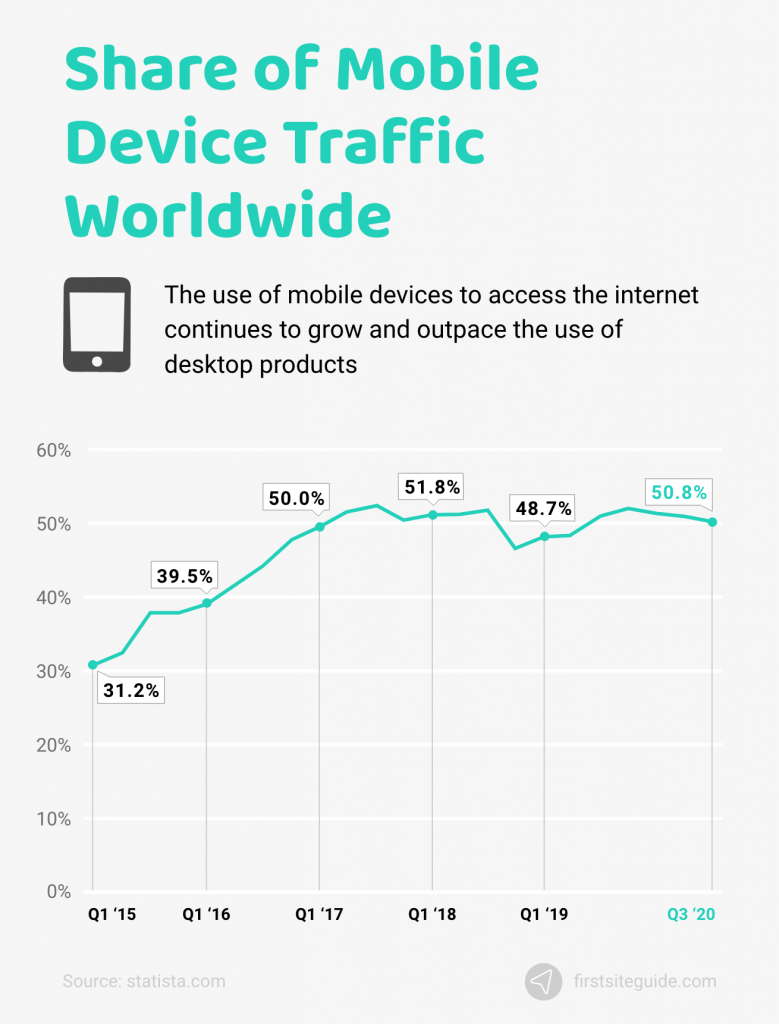
Source: Statista.com
2. Mobile network data traffic grew 50% between Q3 2019 and Q3 2020.
2019 was a big year for the growth of mobile network data traffic. From the third quarter of 2019 to the third quarter of 2020, global mobile network data traffic grew about 50%, which is a tremendous rise in popularity.
The average quarter-on-quarter growth for Q3 2020 was 10 percent. That’s probably because of lockdowns and other COVID-19 related restrictions.
Source: Ericsson.com
3. Mobile devices have over 57% of the worldwide market share.
Many companies are continually looking for ways to reach consumers in a profitable way, and mobile devices own 57.34% of the worldwide market share. That’s because mobile devices are continually experiencing rapid growth, while the desktop has slow but stable growth.
We see the dominance of mobile devices a lot in developing countries, such as the African continent, where mobile has beat desktop for quite some time.

Source: Statcounter.com
4. Estimates show that by the end of 2020, 5G coverage is going to reach 15% of all mobile devices.
5G, the fastest mobile broadband connection currently in widespread use, is on the rise. Statistics show that by the end of 2020, 5G coverage is expected to reach 15% of all mobile devices, which is far faster than its predecessor, 4G.
5G is experiencing continual funding and development by broadband companies and governments worldwide due to its monumental superiority over the current standard. 5G promises to solve many connection issues worldwide and streamline internet speeds.
Source: Ericsson.com
5. Estimates show that by 2026, 5G will account for about 54% of total mobile data used.
Estimates show that 5G will have a far greater and faster growth rate than 4G did and that by 2026, about 54% of all mobile data will be from 5G networks.
5G, while still a technology in its infancy, promises to speed up the global broadband connection speed by a considerable margin. This is making it a far more appealing investment than 4G.

Source: Ericsson.com
6. In February 2021, 9% of all smartphones have 1920×1080 resolution.
Mobile phones have come a long way since their inception, and these days companies are competing for who can offer the best DPI, resolution, and screen quality. Most phones in 2021 have 1920×1080 resolution, which is also known as Full HD.
It wasn’t that long ago when television sets couldn’t offer Full HD resolution, so this development marks a milestone in display technology.

Source: Statcounter.com
Top mobile internet activities
What you do on and with your mobile device dictates how you spend a lot of your time. If you’re like most people, you probably use your phone to watch movies or videos on the internet. Yet, while entertainment is the leading category in mobile internet activities, many people use their devices for a lot of other activities.
You’d be surprised at just how many mobile internet activities there are, and while most of them are rooted in either entertainment or social media, phones are a surprisingly popular business tool as well.
Let’s take a look at the numbers in regards to the most popular mobile internet activities.
7. The leading smartphone activity in 2017 was email with 59%.
The most popular smartphone activity in 2017 was emailing. Phones are handy, portable, and available, making them great communication tools. Emails were the most popular smartphone activity by about 59%, followed closely by social media.
Source: Statista.com
8. The most popular application category in 2021 was a video with 47 exabytes used.
The most popular category of application has always been something related to entertainment, and these days, that’s video. Video accounted for over 47 exabytes of data, making it the most popular application category in 2021.
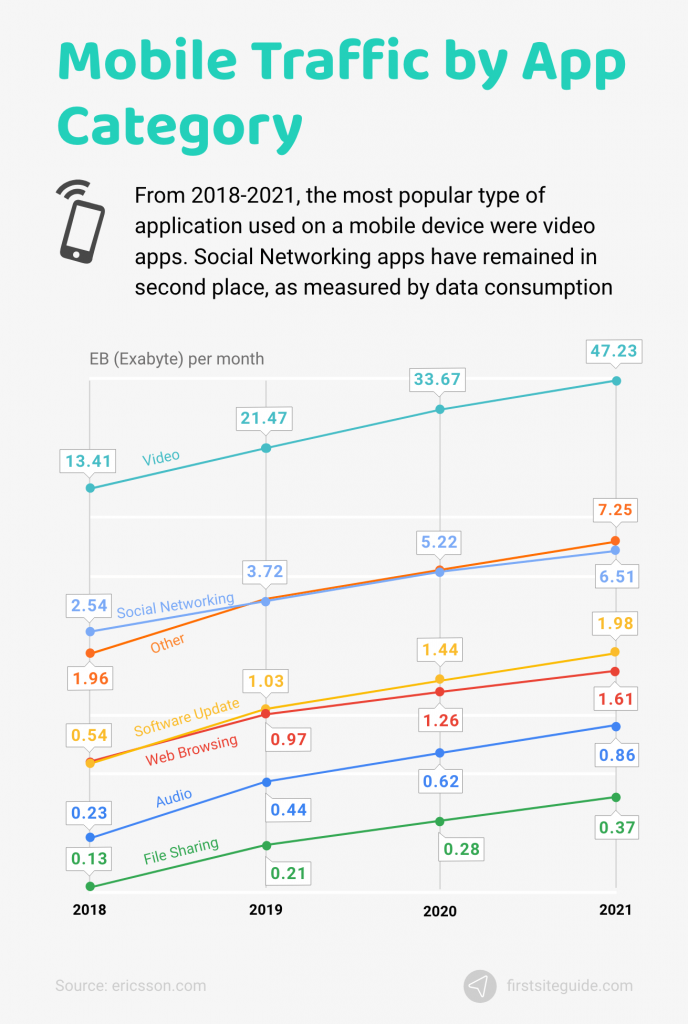
Source: Ericsson.com
9. The leading application in the Apple App Store as of September 2020 was TikTok, with 8.15 million downloads.
Trends come and go, and the title of the most popular phone application is constantly changing hands. Generally, the leading application is a messaging app or social media platform. In 2020, the most popular app in the Apple App Store was TikTok, a Chinese video-sharing social networking service.
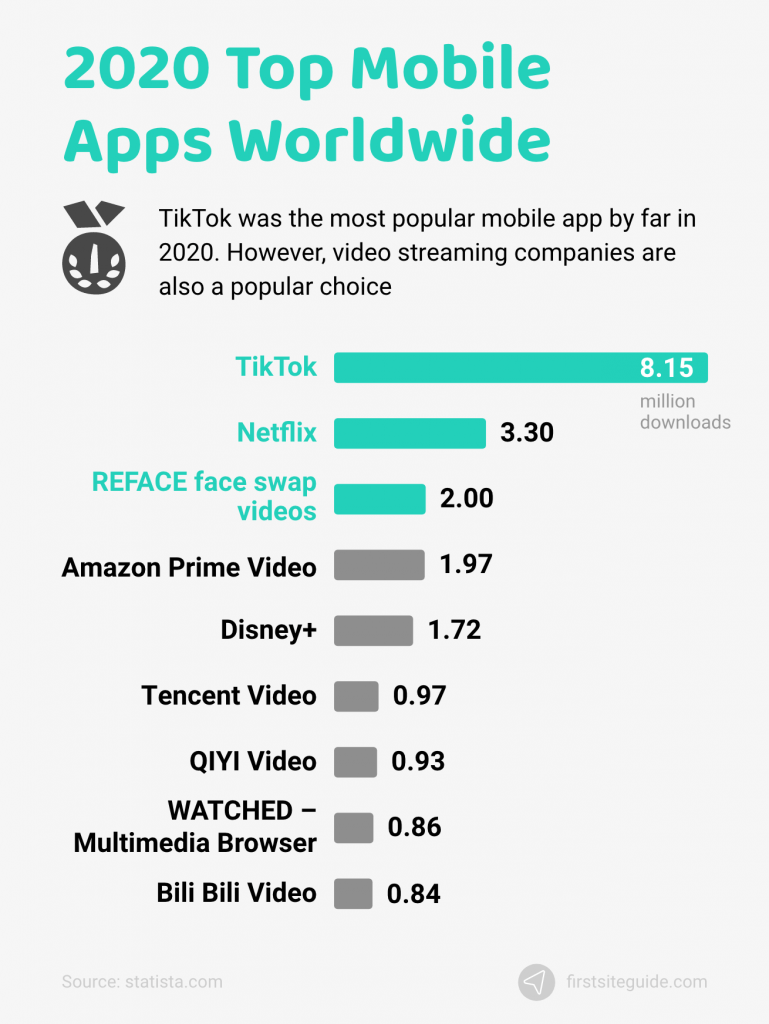
Source: Statista.com
10. WhatsApp is the most popular messaging app in January 2021 with 2 billion active users.
The leading messaging platform app as measured by active monthly users is WhatsApp, which boasts about 2 billion active monthly users in January 2021. WhatsApp is followed by Facebook Messenger with 1.3 billion active monthly users and WeChat with 1.213 billion active monthly users.
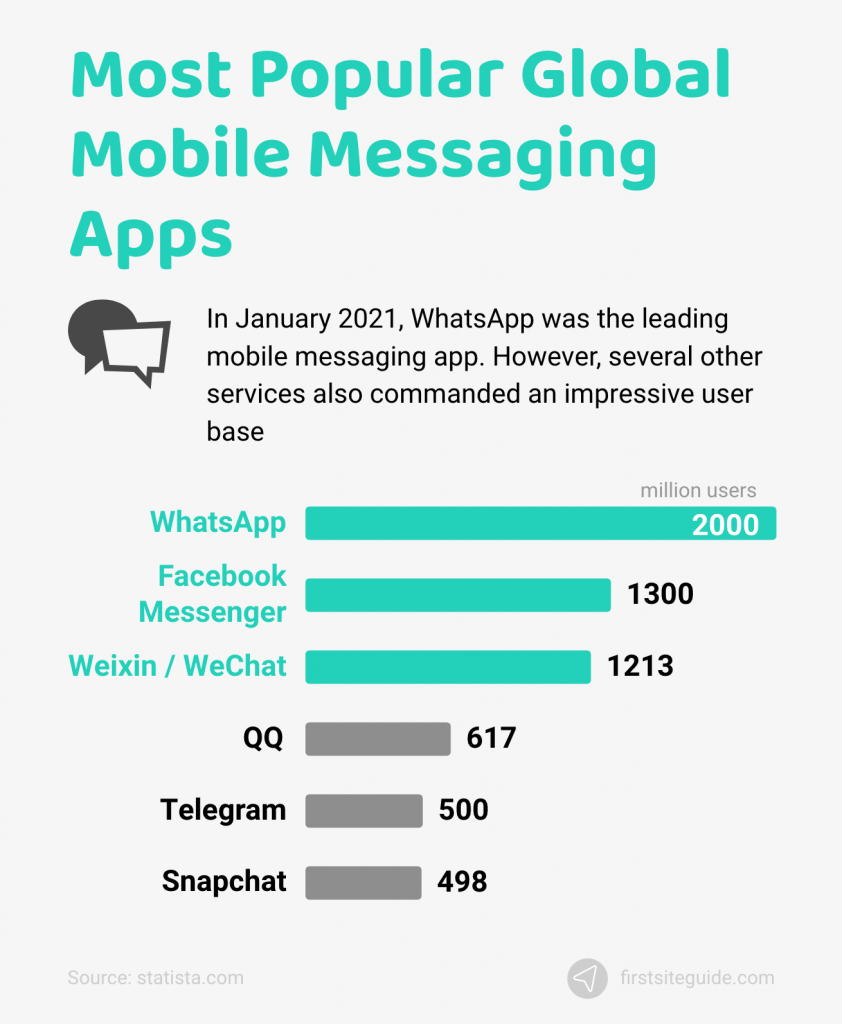
Source: Statista.com
11. In 2020, consumers spent about $111 billion dollars on apps in the Google Play Store and the Apple App Store.
Apps are a profitable business. In 2020, consumers spent about $111 billion dollars on apps from the Apple App Store and the Google Play Store. By 2024, this number is expected to reach a whopping $171 billion.
Source: Statista.com
12. 26% of US smartphone users have between 11 to 20 apps installed on their phone.
Smartphones have been made better with the advent of smartphone apps. For many US smartphone users, the average number of apps on their device is anywhere from 11 to 20. About 26% of US smartphone users have this amount of apps on their phones.
Source: Audienceproject.com
13. 58% of smartphone users prefer services whose mobile websites or apps remember them and their past activities.
Online privacy is on the rise, but even so, about 58% of smartphone users prefer when a mobile app or mobile website remembers them and their past browsing activity.
Source: Thinkwithgoogle.com
14. About 63% of all smartphone users are more likely to buy from websites and apps that make relevant recommendations.
There are a lot of smartphone eCommerce apps and websites. Most of them employ a suggestion system that recommends relevant products and services based on prior searching, and smartphone users seem to like that.
Source: Thinkwithgoogle.com
15. US smartphone users spend about 82 minutes on smartphone based social media apps and websites daily.
Smartphones can get quite addictive, and that’s because they’re so convenient. In 2019, US smartphone users’ average amount of time spent on social media per day was approximately 76 minutes.
This number is expected to rise in the coming years and is predicted to increase to 82 daily minutes in 2020, primarily due to the movement restrictions posed by the SARS-COV-2 pandemic.

Source: Statista.com
16. 23% of communication service providers have announced 5G mobile cloud gaming support on a separate subscription.
Mobile gaming was once frowned upon, but as mobile devices continue to get better and better, mobile gaming becomes more popular. The only factor that’s been holding mobile gaming back is internet speed.
23% of communication service providers have announced that they will release 5G Mobile cloud gaming support to eliminate as much lag as possible.
Source: Ericsson.com
The geography of mobile traffic
Mobile traffic, while universal, isn’t the same everywhere. Some places have slow internet speeds at high prices, while other places have lightning-fast internet speeds offered at affordable prices.
Where you are in the world can be a defining aspect to your mobile internet use. While the global share of mobile internet use has surpassed desktop internet use for the first time in history, some continents such as Africa experienced this surge years ago.
Let’s take a look at some of the more interesting mobile traffic numbers from a geographical perspective.
17. The fastest mobile connection speed is in South Korea with 113 Mbps.
South Korea is a technological utopia. All of the latest technology, new developments, and innovation find their first foothold in South Korea. It’s the leading country for mobile connection speed with a peak of 113.01 Mbps.
Singapore is the leading country in average connection speed with 57.27 Mbps, 8.75 Mbps faster than the second-place country, Norway.

Source: Statista.com
18. The biggest mobile traffic driver in the world by country is India with 12GB per month in 2019.
India is the leading country in smartphone traffic expenditure with an average of 12GB per month per person in 2019. This number is expected to increase by 1.3GB per person in 2020.

Source: Ericsson.com
19. In the US, mobile apps accounted for 88% of online minutes spent via mobile in 2020.
Most smartphone users prefer using designated mobile apps rather than mobile websites. This shows in the minutes spent on the internet via a mobile device. In 2020, about 88% of the online minutes spent by US smartphone users came through mobile apps.
Source: Statista.com
20. Mobile apps account for 56% of web page views worldwide in 2021.
Mobile apps have slowly overtaken desktop products when it comes to web page views. In 2021, they’ve beaten desktop by about 5.64%, since mobile apps account for 55.64% of web page views.
Source: Statista.com
The 5G and 6G future of mobile broadband
It used to take hours to download the most straightforward app on your phone, but these days it only takes minutes. Depending on the type of mobile broadband, minutes can turn into seconds with just one generation worth of innovation. The jump from 4G to 5G was astounding, with 5G offering far faster speeds.
While 5G is still relatively new, 6G is already in development, and it promises to offer even faster speeds than 5G technology can.
Let’s take a look at the future of 5G and 6G mobile broadband, as well as the connection speeds, spread, and global coverage of these promising networks.
21. 5G coverage is expected to reach 60% by 2026.
5G is the latest generation of mobile broadband technology, and it’s being adopted as the global standard at a rapid pace. 5G is expected to dominate about 60% of the global broadband connection market as soon as 2026.
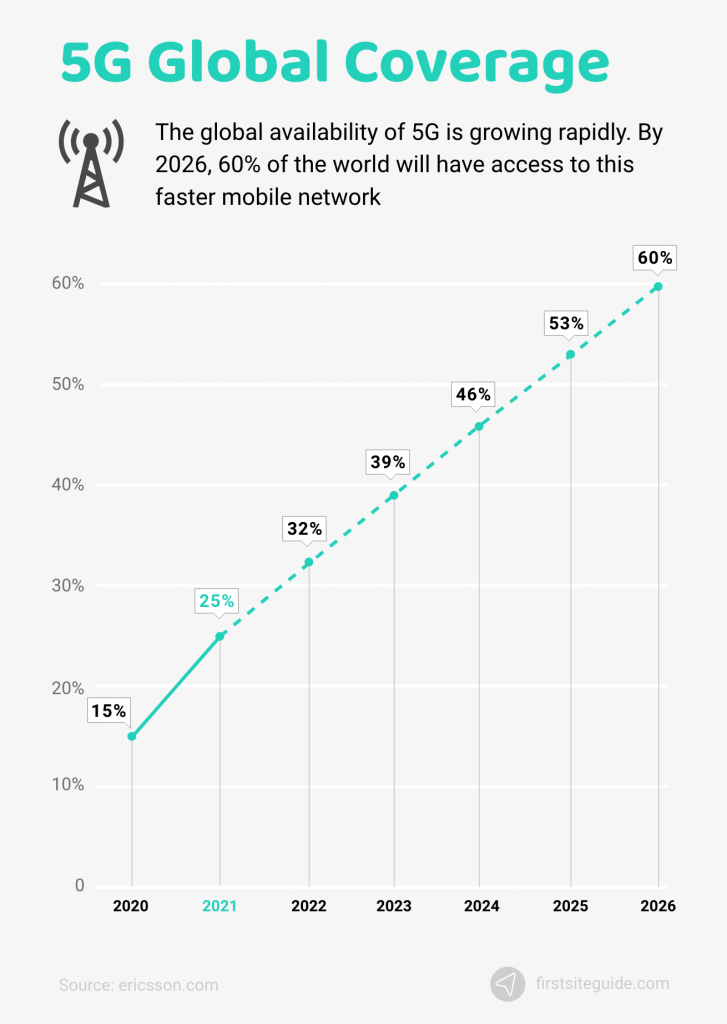
Source: Ericsson.com
22. 5G networks are expected to carry more than 50% of the world’s mobile data traffic in 2026.
5G networks are on the rise, and since they’ll probably grow at a faster rate than their predecessor 4G ever did, total global mobile data traffic is estimated to reach around 51 exabytes per month by the end of 2020, and about 226 exabytes per month in 2026.
Source: Ericsson.com
23. 5G is projected to have a 10% faster uptake than 4G did in the same timeframe.
The adaptation of technology can be a lightning-fast or a slow process, and that often depends on how the innovation in question could impact the world. In terms of connection, 5G promises to take connection speeds to the very next level, far more than 4G ever did.
This is why 5G is projected to have a 10% faster uptake than 4G did in the same timeframe.
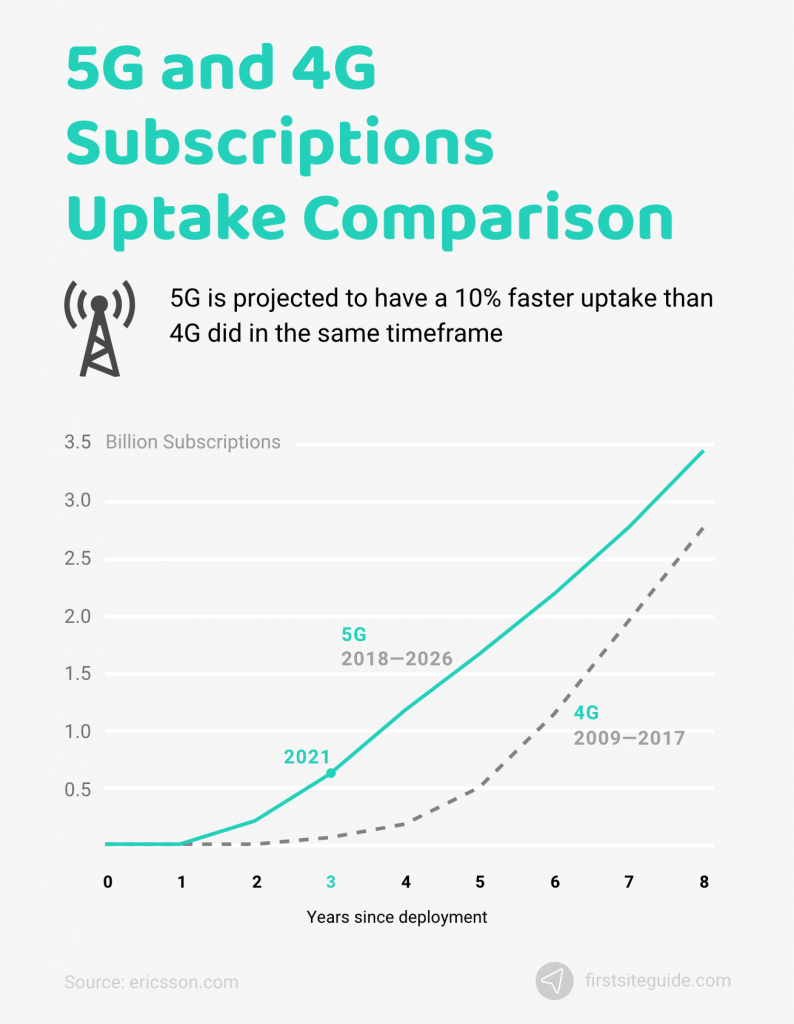
Source: Ericsson.com
24. 6G is projected to offer 10 times faster connection speeds than 5G.
Just because 5G is the latest mobile broadband connection trend doesn’t mean that people aren’t already looking to the future. 5G is a technology that is still in its infancy, but it’s by far the fastest mobile broadband connection technology currently available with about 100 Mbit/s.
6G technology is currently in development. It promises to offer a connection speed of 1,000 Mbit/s, which is ten times faster than 5G. This would completely revolutionize mobile connections as we currently know them.
Source: Statista.com
Conclusion
The world of smartphones is getting bigger and bigger. As smartphones improve every year, they’re proving to be an increasingly appealing opportunity for businesses around the globe.
Many current businesses now skip the desktop phase entirely in favor of smartphone developments. If smartphones continue developing and if the connection speeds keep becoming faster, the future will soon fit right into your pocket.
Have got to agree here, mobile devices are becoming a more and more integral part of our lives. Nowadays websites need to be optimized for mobile devices if they want to rank for their keywords. Thank you for this information!
Thanks Yakub!